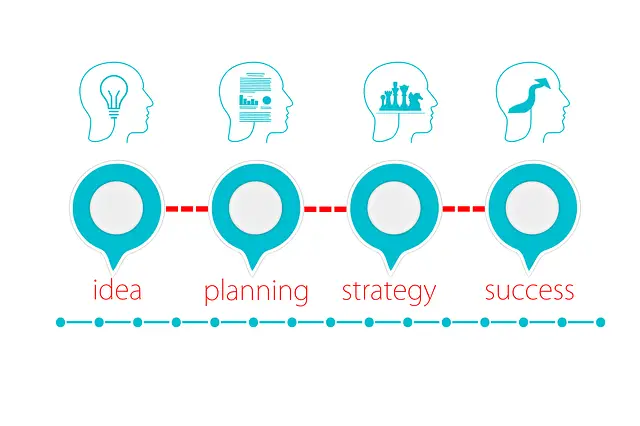Planning involves creating a specific plan of action for achieving certain objectives, while strategy involves making decisions that will bring about long-term success. Planning helps to lay out the steps needed to reach your goals, while strategizing allows you to consider all possible options in order to identify the best course of action.
What is planning?
(Photo by Alvaro Reyes on Unsplash )

Planning is the process of setting goals, developing policies and procedures to achieve those goals, and then allocate resources to carry out the plan. Strategy is the overall approach an organization takes to achieve its goals.
The planning process begins with defining the organization’s overall objectives. Once objectives are established, policies and procedures are developed to ensure they are met. The final step in planning is allocating resources to carry out the plan.
What is strategy?
(Image by Gerd Altmann from Pixabay )

Strategy is a high-level plan that establishes a specific course of action to achieve a goal or objectives. It is different from planning in that it takes into account the resources and capabilities available to the organization, as well as the competitive landscape.
The strategic planning process involves setting goals, identifying and assessing opportunities and risks, and developing a plan of action to achieve the goals. Once the strategy is in place, businesses can develop operational plans to support it.
There are different types of strategies that organizations can adopt, including growth strategies, turnaround strategies, and stability strategies. The type of strategy chosen should be based on the organization’s strengths, weaknesses, and opportunities.
Planning Vs. Strategy – Key differences
Planning and strategy are related concepts, but they have some key differences. Here are some of the main differences between planning and strategy:
Scope: Planning tends to be more focused on short-term or immediate goals, while strategy is more focused on long-term goals and objectives. Planning is often more tactical, while strategy is more overarching.
Level of detail: Planning tends to be more detailed and specific, while strategy is more general and high-level. Planning involves figuring out the specific steps needed to achieve a goal, while strategy involves setting broad goals and directions.
Time horizon: Planning is often focused on the present or near future, while strategy is focused on the long-term. Planning is concerned with what needs to be done now, while strategy is concerned with what needs to be done to achieve long-term success.
Flexibility: Planning tends to be more rigid and structured, while strategy allows for more flexibility and adaptation. Planning often involves following a set plan or schedule, while strategy involves being able to adjust to changing circumstances and goals.
Alignment: Planning is focused on ensuring that day-to-day activities and tasks are aligned with the goals and objectives of the organization or project. Strategy, on the other hand, is focused on aligning the overall direction of the organization or project with broader goals and objectives.
Planning and strategy are both important for achieving success, but they differ in terms of scope, level of detail, time horizon, flexibility, and alignment. Effective organizations and individuals need to be able to balance both planning and strategy to achieve their goals.
When to use planning and when to use strategy
Planning and strategy are both important for achieving success, but they serve different purposes and are used in different contexts. Here are some guidelines for when to use planning and when to use strategy:
- Planning is used when you need to accomplish a specific task or goal within a defined period of time. Planning is often used for short-term projects, such as organizing an event, writing a report, or creating a budget.
- Strategy is used when you need to establish long-term goals and directions for your organization or project. Strategy is often used for longer-term projects, such as creating a new product, entering a new market, or expanding a business.
- Planning is more focused on implementation and execution, while strategy is more focused on vision and direction. Planning involves figuring out the specific steps needed to achieve a goal, while strategy involves setting broad goals and directions.
- Planning is more tactical, while strategy is more overarching. Planning involves specific actions that need to be taken to achieve a goal, while strategy involves overall approaches and principles that guide decision-making.
- Planning is more detail-oriented, while strategy is more abstract. Planning involves figuring out the specific details of how something will be done, while strategy involves more general concepts and ideas.
Planning is used to achieve short-term goals and objectives, while strategy is used to establish long-term goals and directions for an organization or project. Effective organizations and individuals need to be able to balance both planning and strategy to achieve their goals.
What are the 5 Ps of strategy?
The 5 Ps of strategy are:
- Purpose: What is the company or organization trying to achieve?
- Plan: What are the specific steps that will be taken to achieve the purpose?
- People: Who will be responsible for carrying out the plan?
- Partnerships: Which other organizations will be involved in helping to achieve the purpose?
- Performance: How will progress be measured and how will success be defined?
What are the 4 stages strategy?
The four stages strategy is a process that helps businesses create and implement effective strategies. The four stages are:
- Set objectives: In this stage, businesses identify what they want to achieve and set specific, measurable goals.
- Conduct market research and analysis: This step involves understanding the target market, the competition, and the business’s strengths and weaknesses.
- Develop strategic options: Based on the research conducted in the previous step, businesses develop different options for achieving their objectives.
- Implement and monitor strategy: Once a strategy is chosen, it needs to be implemented and monitored to ensure it is effective.
What are types of planning?
There are many types of planning, but some common ones include Strategic planning, Marketing planning, Financial planning, and Production planning.
Strategic planning is a long-term process that helps organizations set goals and objectives and create a plan to achieve them.
Marketing plans are created to help organizations reach their target markets and achieve their marketing objectives.
Financial plans help organizations budget for their activities and track their progress towards financial goals.
Production plans help organizations manage their resources and schedules to efficiently produce goods or services.
What are the 4 elements of planning?
- Setting goals: This is the first and most important step in the planning process. Without goals, you will have nothing to work towards and no way to measure your success.
- Developing a plan: Once you have set your goals, you need to develop a plan of action. This will involve creating a timeline, identifying resources, and outlining the steps you need to take to reach your goals.
- Implementing the plan: Once the plan is in place, it’s time to put it into action. This step will require some coordination and effort, but if executed properly, will help you achieve your desired results.
- Evaluating progress: As you work towards your goals, it’s important to periodically stop and assess your progress. This will help you identify any areas that need improvement and make necessary adjustments to ensure you remain on track.
Featured Image By – JESHOOTS.COM on Unsplash








